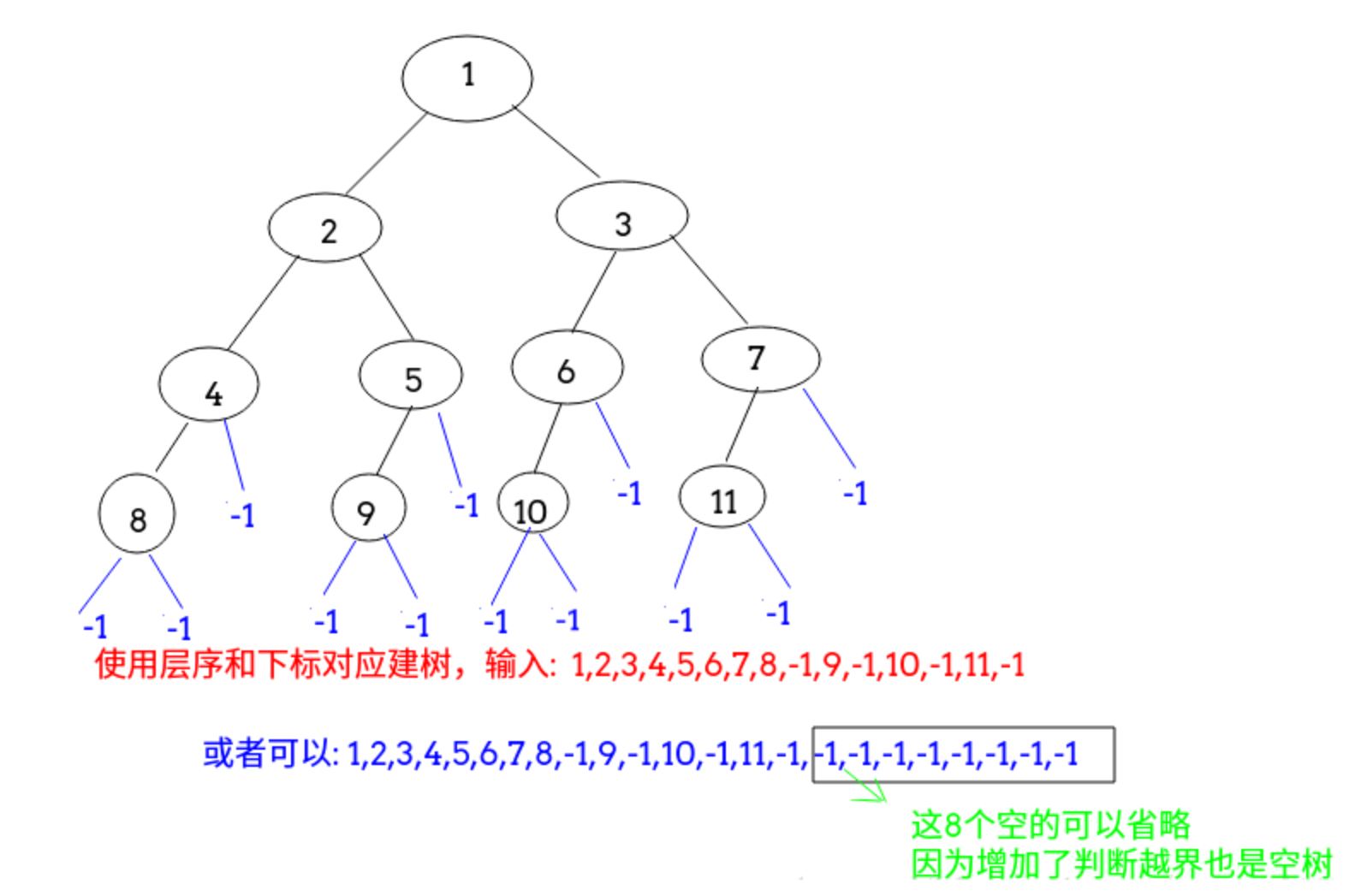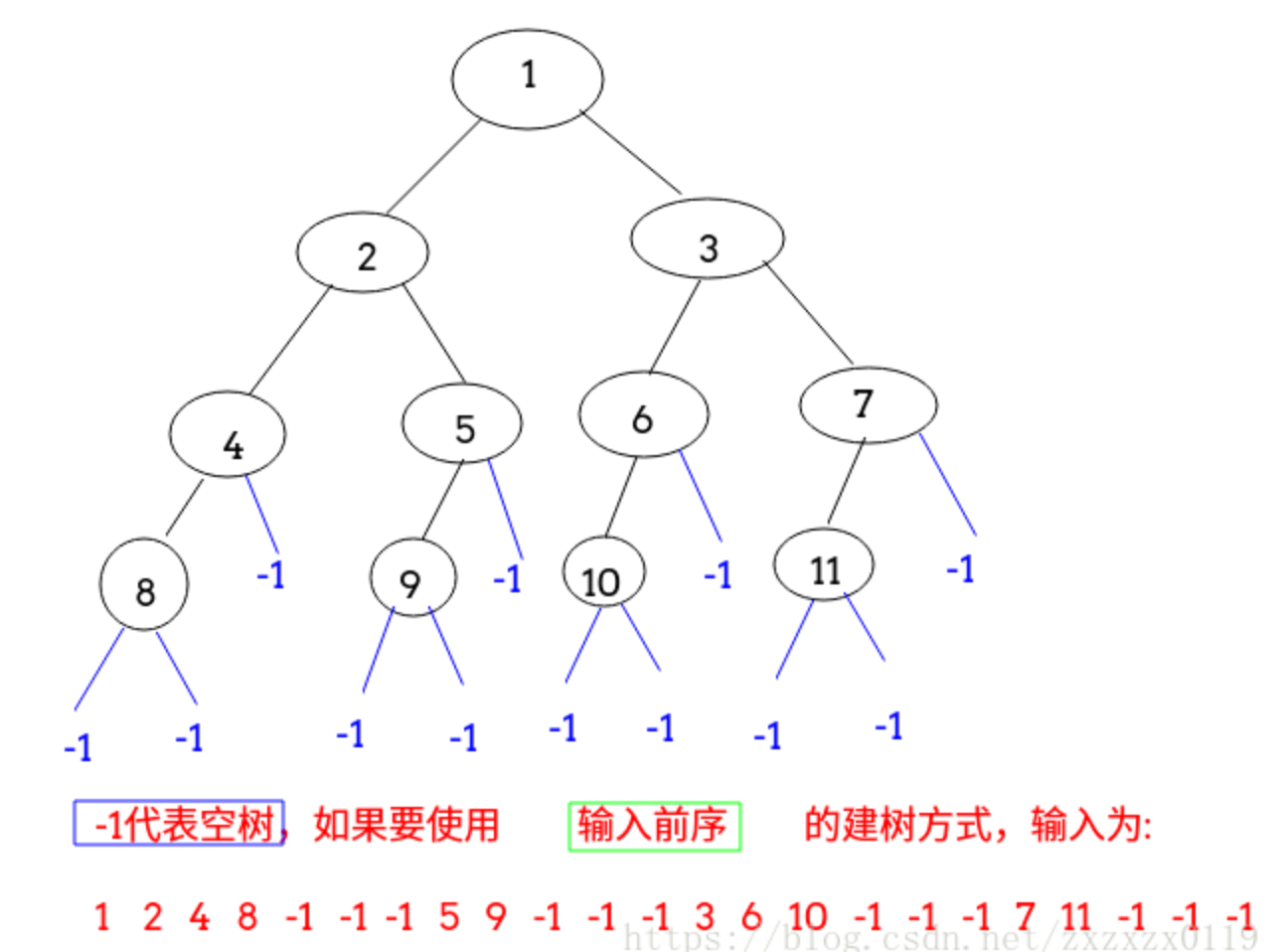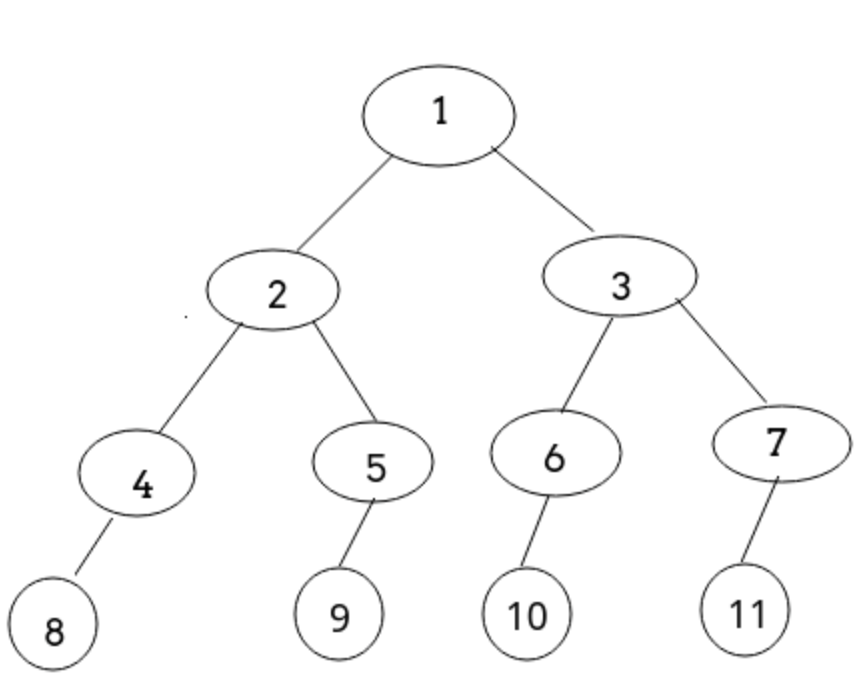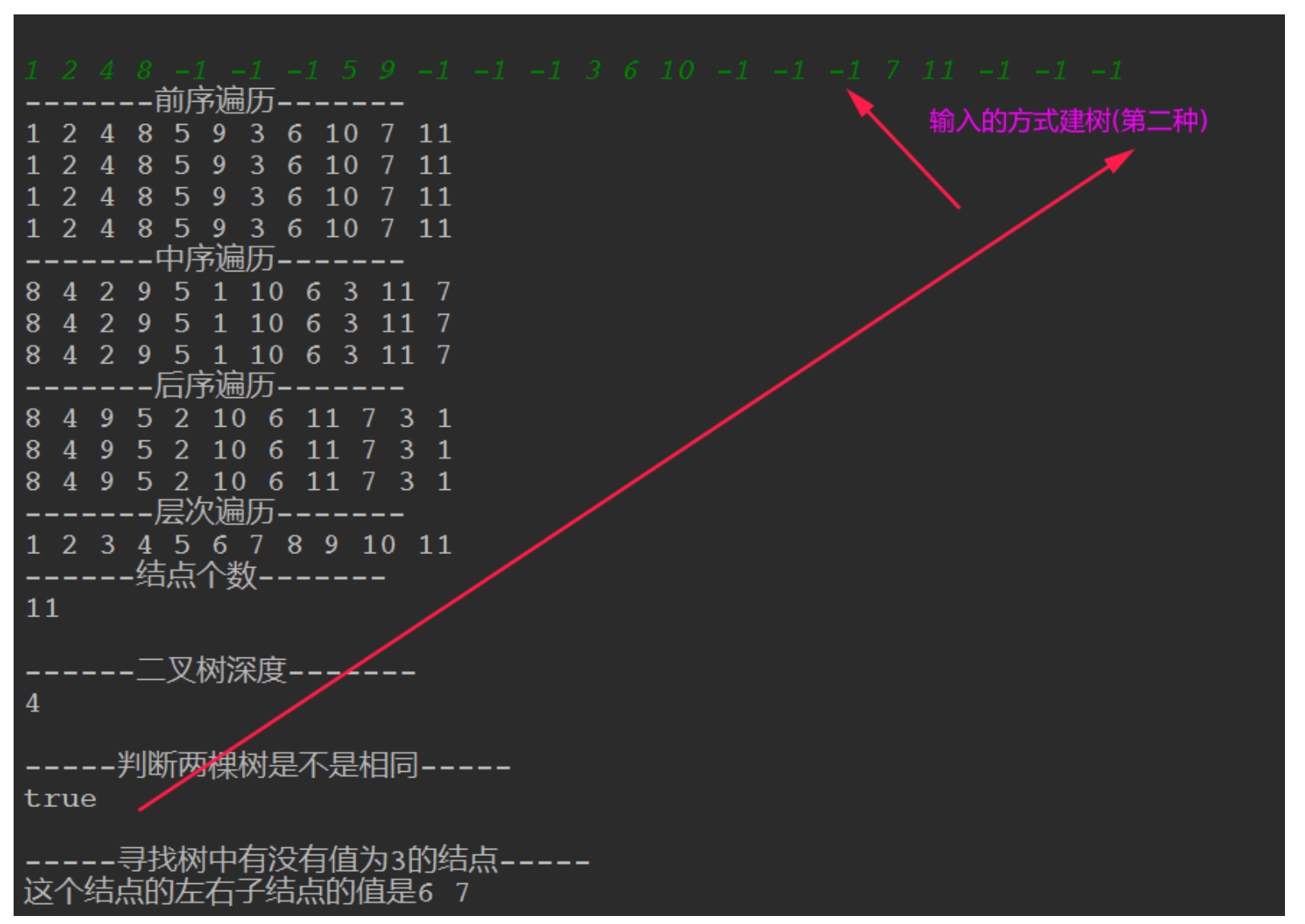二叉树的各种操作(递归和非递归遍历,树深度,结点个数等等)
二叉树建立
先给出结点结构:
static class Node {public int val;public Node left;public Node right;public Node(int val) {this.val = val;}}
两种建立方式:
- 可以根据二叉树根节点和左右子结点的下标关系递归建立二叉树,层次输入二叉树结点;
- 也可以使用输入流前序建立二叉树(注意空树要输入-1);
1、根据下标关系
// given a arr to buildstatic Node createTree(int arr[], int i) {if (i >= arr.length || arr[i] == -1)return null;Node root = new Node(arr[i]);root.left = createTree(arr, 2 * i + 1);root.right = createTree(arr, 2 * i + 2);return root;}
大致过程如下:
2、前序输入(cin)建立
// cin methodstatic Node buildTree(Scanner cin) {Node root = null;int data = cin.nextInt();if (data != -1) {root = new Node(data);root.left = buildTree(cin);root.right = buildTree(cin);}return root;}
过程如下:
前序遍历
1、递归前序
static void preOrder(Node T) {if (T == null)return;System.out.print(T.val + " ");preOrder(T.left);preOrder(T.right);}
2、非递归前序
前序遍历顺序为: 根结点->左子树->右子树,所以对于正在访问的根结点,可以直接访问,访问完之后,按照相同的方式访问左子树,再访问右子树,过程如下 :
- 如果当前节点
p不为空,访问结点p,并将结点p入栈,并继续访问左子树(直到左子树为空); - 否则将栈顶元素出栈,并访问栈顶的元素的右子树;
- 直到栈为空且
p为空,循环结束。
代码:
static void iterativePre(Node root) {Stack<Node> s = new Stack<>();Node p = root;while (!s.empty() || p != null) {if (p != null) {//也可以写一个while循环,直到左子树为空s.push(p);System.out.print(p.val + " ");p = p.left;} else {p = s.pop();p = p.right;}}}
也可以将上面的一直访问到左子树为空写成一个while循环:
static void iterativePre2(Node root) {Stack<Node> s = new Stack<>();Node p = root;while (!s.empty() || p != null) {while (p != null) { // while循环,直到左子树为空s.push(p);System.out.print(p.val + " ");p = p.left;}p = s.pop();p = p.right;}}
还有另外一种写法是:
- 先把根节点入栈,然后每次出栈一个元素,先访问这个元素,然后如果它的右子树存在,就入栈,如果它的左子树存在也入栈;
- 为什么要先入右子树呢,因为,前序遍历是中->左->右,而栈可以逆序,所以先右再左;
这个方法在后续遍历的双栈法中有体现,那个只是这个稍微的修改。
static void iterativePre3(Node root) {if (root == null)return;Node p = root;Stack<Node> stack = new Stack<>();stack.add(p);while (!stack.isEmpty()) {p = stack.pop();System.out.print(p.val + " ");if (p.right != null)// 先右再左即可stack.push(p.right);if (p.left != null)stack.push(p.left);}}
中序遍历
1、递归中序
static void inOrder(Node T) {if (T == null)return;inOrder(T.left);System.out.print(T.val + " ");inOrder(T.right);}
2、非递归中序
中序遍历 : 左子树->根->右子树,过程如下:
- 当前节点不空
!= null,压入栈中(和前序遍历不同的是,不需要打印),当前节点向左; - 当前节点为空
== null,从栈中拿出一个并且打印(在这里打印) ,当前节点向右;
直到栈为空且p为空,循环结束。
/*** 1)、当前节点不空(!=null),压入栈中(和前序遍历不同的是,不需要打印),当前节点向左;* 2)、当前节点为空(==null),从栈中拿出一个并且打印(在这里打印) ,当前节点向右;*/static void iterativeIn(Node root) {if (root == null)return;Stack<Node> s = new Stack<>();Node p = root;while (!s.empty() || p != null) {if (p != null) {s.push(p);p = p.left;} else {p = s.pop();System.out.print(p.val + " "); //在这里打印p = p.right;}}}
同理,那个一直访问左孩子那里也可以改成whlie:
static void iterativeIn2(Node root) {if (root == null)return;Stack<Node> s = new Stack<>();Node p = root;while (!s.empty() || p != null) {while (p != null) { //这里改成whiles.push(p);p = p.left;}p = s.pop();System.out.print(p.val + " "); //在这里打印p = p.right;}}
后序遍历
1、递归后序
static void postOrder(Node T) {if (T == null)return;postOrder(T.left);postOrder(T.right);System.out.print(T.val + " ");}
2、非递归后序
1)、双栈法
这个其实就是非递归前序(iterativePre3)的稍微一点改进。
- 首先,前序遍历入栈(
iterativePre3)的顺序是先 右 再左; - 这时,我们可以做到反过来先 左 再右,这样遍历的顺序可以做到 “中右左”,而后续遍历是 “左右中”,正好是前面那个的相反,所以我们再使用一个栈反转保存即可;
代码:
/*** 非递归后续1(双栈法解决非递归后续)* 后续遍历是要实现 左->右->中* 这个方法和前序遍历的第二种方法 只是多了一个栈而已* 因为 前序遍历是 中->左->右 压栈顺序是 右->左* 这样,我们就很容易实现 中->右->左遍历 压栈顺序是 左->右* 而后续遍历是要实现 左->右->中,* 我们把上面的 中右左 压入到另一个栈中 就实现了 左右中*/static void iterativePos(Node root) {Stack<Node> s = new Stack<>(), s2 = new Stack<>();Node p;s.push(root);while (!s.empty()) {p = s.pop();s2.push(p);if (p.left != null) s.push(p.left); //这里是先左再右 (非递归前序是先右再左)if (p.right != null) s.push(p.right);}while (!s2.empty())System.out.print(s2.pop().val + " ");}
2)、设置pre结点
过程如下:
- 对于任一结点
p,先将其入栈; - 可以访问的情况: ①若
p不存在左孩子和右孩子,则可以直接访问它。②或者p存在左孩子或者右孩子,但是左孩子和右孩子都已经被访问过了,则也可以直接访问该结点; - 若非上述两种情况,则将右孩子和左孩子依次入栈。这样可以保证每次取栈顶元素时,左孩子在右孩子前面被访问,根结点在左孩子和右孩子访问之后被访问;
代码:
/*** 非递归后续2(设置pre结点) */static void iterativePos2(Node root) {Node cur, pre = null;Stack<Node> s = new Stack<>();s.push(root);while (!s.empty()) {cur = s.peek();// 两种可以访问的情况if ((cur.left == null && cur.right == null) ||((pre != null) && (pre == cur.left || pre == cur.right))) {System.out.print(cur.val + " ");s.pop();pre = cur;} else {if (cur.right != null) s.push(cur.right);if (cur.left != null) s.push(cur.left);}}}
层次遍历
很简单。利用队列BFS即可.
算法思想:
1.初始将根入队并访问根节点,然后出队
2.若有左子树,则将左子树入队
3.若有右子树,则将右子树入队
4.然后出队,访问该节点
5.反复该过程直到队列为空
static void levelOrder(Node root) {if (root == null)return;Queue<Node> queue = new LinkedList<>();queue.add(root);while (!queue.isEmpty()) {Node now = queue.poll();System.out.print(now.val + " ");if (now.left != null) queue.add(now.left);if (now.right != null) queue.add(now.right);}}
寻找树中有没有值为x的结点
递归条件有两个,一个是为空代表没找到,找到了的话直接返回,否则递归查找左右子树。
//查找某个值为x的结点static Node search(Node T, int x) {if (T == null)return null;if (T.val == x)return T;else {if (search(T.left, x) == null)return search(T.right, x);elsereturn search(T.left, x);}}
统计树中结点的个数
树中结点的个数等于根节点(1) + 左子树结点个数 + 右子树的个数,递归求解即可。
//统计结点个数static int count(Node T) {if (T == null)return 0;elsereturn count(T.left) + count(T.right) + 1;}
计算树的高度
也是递归求解,左右子树的高度中的比较高的加上根节点就是树的高度。
//计算二叉树的深度static int depth(Node T) {if (T == null)return 0;return Math.max(depth(T.left), depth(T.right)) + 1;}
判断两棵树是不是相等
也是递归求解,两棵树相等,既要根节点的值相等,而且左右子树也要相等。
//判断两棵树是不是相等static boolean is_SameTree(Node T1, Node T2) {if (T1 == null && T2 == null)return true;else {return T1 != null && T2 != null && T1.val == T2.val&& is_SameTree(T1.left, T2.left) && is_SameTree(T1.right, T2.right);}}
完整测试代码
完整的测试代码,这里输入的样例树(就是建树的时候那个例子)如下:

代码:
import java.io.BufferedInputStream;import java.util.*;public class BinaryTree {static class Node {public int val;public Node left;public Node right;public Node(int val) {this.val = val;}}// given a arr to buildstatic Node createTree(int arr[], int i) {if (i >= arr.length || arr[i] == -1)return null;Node root = new Node(arr[i]);root.left = createTree(arr, 2 * i + 1);root.right = createTree(arr, 2 * i + 2);return root;}// cin methodstatic Node buildTree(Scanner cin) {Node root = null;int data = cin.nextInt();if (data != -1) {root = new Node(data);root.left = buildTree(cin);root.right = buildTree(cin);}return root;}static void preOrder(Node T) {if (T == null)return;System.out.print(T.val + " ");preOrder(T.left);preOrder(T.right);}static void iterativePre(Node root) {Stack<Node> s = new Stack<>();Node p = root;while (!s.empty() || p != null) {if (p != null) {s.push(p);System.out.print(p.val + " ");p = p.left;} else {p = s.pop();p = p.right;}}}static void iterativePre2(Node root) {Stack<Node> s = new Stack<>();Node p = root;while (!s.empty() || p != null) {while (p != null) { // while循环,直到左子树为空s.push(p);System.out.print(p.val + " ");p = p.left;}p = s.pop();p = p.right;}}/*** 理解 : push右子树,再push左子树,这样的话弹栈的时候就是先访问左子树,再右子树*/static void iterativePre3(Node root) {if (root == null)return;Node p = root;Stack<Node> stack = new Stack<>();stack.add(p);while (!stack.isEmpty()) {p = stack.pop();System.out.print(p.val + " ");if (p.right != null)stack.push(p.right);if (p.left != null)stack.push(p.left);}}static void inOrder(Node T) {if (T == null)return;inOrder(T.left);System.out.print(T.val + " ");inOrder(T.right);}/*** 1)、当前节点不空(!=null),压入栈中(和前序遍历不同的是,不需要打印),当前节点向左;* 2)、当前节点为空(==null),从栈中拿出一个并且打印(在这里打印) ,当前节点向右;*/static void iterativeIn(Node root) {if (root == null)return;Stack<Node> s = new Stack<>();Node p = root;while (!s.empty() || p != null) {if (p != null) {s.push(p);p = p.left;} else {p = s.pop();System.out.print(p.val + " "); //在这里打印p = p.right;}}}static void iterativeIn2(Node root) {if (root == null)return;Stack<Node> s = new Stack<>();Node p = root;while (!s.empty() || p != null) {while (p != null) { //这里改成whiles.push(p);p = p.left;}p = s.pop();System.out.print(p.val + " "); //在这里打印p = p.right;}}static void postOrder(Node T) {if (T == null)return;postOrder(T.left);postOrder(T.right);System.out.print(T.val + " ");}/*** 非递归后续1(双栈法解决非递归后续)* 后续遍历是要实现 左->右->中* 这个方法和前序遍历的第二种方法 只是多了一个栈而已* 因为 前序遍历是 中->左->右 压栈顺序是 右->左* 这样,我们就很容易实现 中->右->左遍历 压栈顺序是 左->右* 而后续遍历是要实现 左->右->中,* 我们把上面的 中右左 压入到另一个栈中 就实现了 左右中*/static void iterativePos(Node root) {Stack<Node> s = new Stack<>(), s2 = new Stack<>();Node p;s.push(root);while (!s.empty()) {p = s.pop();s2.push(p);if (p.left != null) s.push(p.left); //这里是先左再右 (非递归前序是先右再左)if (p.right != null) s.push(p.right);}while (!s2.empty())System.out.print(s2.pop().val + " ");}/*** 非递归后续2(设置pre结点) */static void iterativePos2(Node root) {Node cur, pre = null;Stack<Node> s = new Stack<>();s.push(root);while (!s.empty()) {cur = s.peek();// 两种可以访问的情况if ((cur.left == null && cur.right == null) ||((pre != null) && (pre == cur.left || pre == cur.right))) {System.out.print(cur.val + " ");s.pop();pre = cur;} else {if (cur.right != null) s.push(cur.right);if (cur.left != null) s.push(cur.left);}}}static void levelOrder(Node root) {if (root == null)return;Queue<Node> queue = new LinkedList<>();queue.add(root);while (!queue.isEmpty()) {Node now = queue.poll();System.out.print(now.val + " ");if (now.left != null) queue.add(now.left);if (now.right != null) queue.add(now.right);}}//查找某个值为x的结点static Node search(Node T, int x) {if (T == null)return null;if (T.val == x)return T;else {if (search(T.left, x) == null)return search(T.right, x);elsereturn search(T.left, x);}}//统计结点个数static int count(Node T) {if (T == null)return 0;elsereturn count(T.left) + count(T.right) + 1;}//计算二叉树的深度static int depth(Node T) {if (T == null)return 0;return Math.max(depth(T.left), depth(T.right)) + 1;}//判断两棵树是不是相等static boolean is_SameTree(Node T1, Node T2) {if (T1 == null && T2 == null)return true;else {return T1 != null && T2 != null && T1.val == T2.val&& is_SameTree(T1.left, T2.left) && is_SameTree(T1.right, T2.right);}}public static void main(String[] args) {Scanner cin = new Scanner(new BufferedInputStream(System.in));// int[] arr = {1,2,3,4,5,6,7,8,-1,9,-1,10,-1,11,-1, -1,-1,-1,-1,-1,-1,-1,-1};int[] arr = {1, 2, 3, 4, 5, 6, 7, 8, -1, 9, -1, 10, -1, 11, -1};Node root = createTree(arr, 0);// 树结构和上面相同,输入: 1 2 4 8 -1 -1 -1 5 9 -1 -1 -1 3 6 10 -1 -1 -1 7 11 -1 -1 -1Node root2 = buildTree(cin);System.out.println("-------前序遍历-------");preOrder(root);System.out.println();iterativePre(root);System.out.println();iterativePre2(root);System.out.println();iterativePre3(root);System.out.println("\n" + "-------中序遍历-------");inOrder(root);System.out.println();iterativeIn(root);System.out.println();iterativeIn2(root);System.out.println("\n" + "-------后序遍历-------");postOrder(root);System.out.println();iterativePos(root);System.out.println();iterativePos2(root);System.out.println("\n" + "-------层次遍历-------");levelOrder(root);System.out.println("\n" + "------结点个数-------");System.out.println(count(root));System.out.println("\n" + "------二叉树深度-------");System.out.println(depth(root));System.out.println("\n" + "-----判断两棵树是不是相同-----");System.out.println(is_SameTree(root, root2));System.out.println("\n" + "-----寻找树中有没有值为3的结点-----");Node Find = search(root, 3);if (null == Find)System.out.println("没有找到结点");elseSystem.out.println("这个结点的左右子结点的值是" + Find.left.val + " " + Find.right.val);}}
运行效果如下图:


